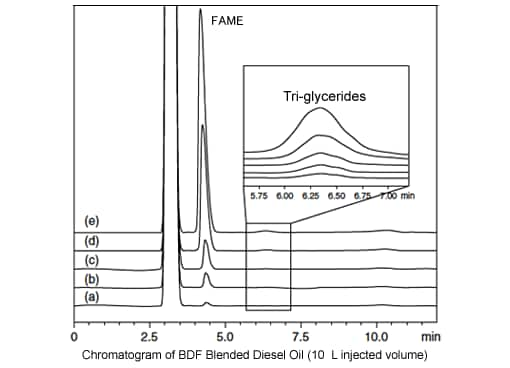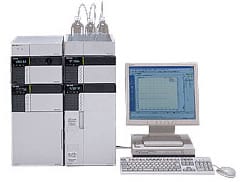Analysis of Fatty Acid Methyl Esters (FAME) and Tri-glycerides in Biodiesel Fuel
To reduce the burden of automotive fuels on the environment, attempts are being made to use substances derived from biomass as fuel. Of these, fatty acid methyl esters (FAME) from methyl esterification of vegetable oil or other oils are attracting interest as biodiesel fuel (BDF). In addition, there is a trend to use biodiesel fuel blended with diesel oil (BDF blended diesel oil) in normal diesel vehicles. Therefore, new items added to the test standards and the corresponding testing procedures are being investigated to ensure stable quality.
FAME and tri-glycerides were analyzed in diesel oil spiked with various concentrations of waste food oil methyl esters and palm oil using HPLC.
Spiked concentration (methyl esters, palm oil) (wt%)
(a)0.1 , 0.01
(b) 0.5 , 0.02
(c) 1.0 , 0.03
(d) 5.0 , 0.05
(e)10.0, 0.10

Broadening and distortion of the peaks may occur for both FAME and tri-glycerides, as the samples contain various components. However, these can be quantified using the grouping function of the data processing software.
High-Performance Liquid Chromatograph

A high-performance liquid chromatograph (HPLC) measures the content of various components in a sample. A liquid medium flows through the HPLC flow channel. When a sample is introduced into the instrument, the components of the sample are separated in a column and the amount of each component is measured by a detector. HPLC can handle a much wider range of target samples and components than GC, including difficult-to-vaporize and heat-sensitive components.


